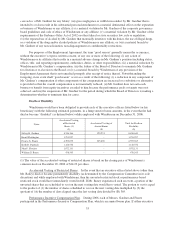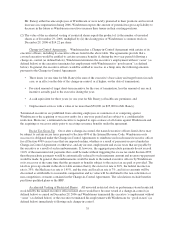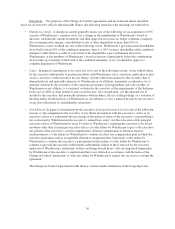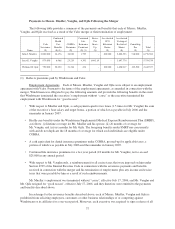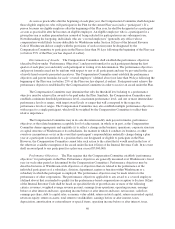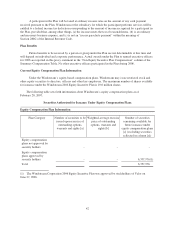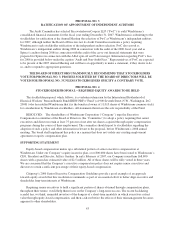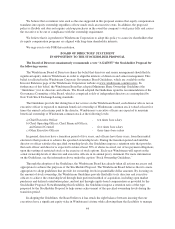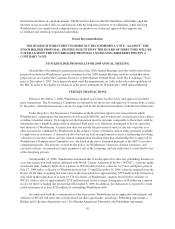Windstream 2006 Annual Report Download - page 39
Download and view the complete annual report
Please find page 39 of the 2006 Windstream annual report below. You can navigate through the pages in the report by either clicking on the pages listed below, or by using the keyword search tool below to find specific information within the annual report.
Mr. Raney) either became employees of Windstream or were newly promoted to their positions and received
increases in compensation during 2006, Windstream expects the amount of potential tax gross-up liability to
decrease in the future as Windstream executives increase their tenure in their existing positions.
(2) The value of the accelerated vesting of restricted shares equals the product of (i) the number of unvested
shares as of December 29, 2006, multiplied by (ii) the closing price of Windstream’s common stock on
December 29, 2006 of $14.22 per share.
Change-in-Control Agreements. Windstream has a Change-in-Control Agreement with certain of its
executive officers, including its executive officers listed in the above table. The agreements provide that a
covered executive would be entitled to certain severance benefits if, during the two-year period following a
change-in- control (as defined below), Windstream terminates the executive’s employment without “cause” (as
defined below) or the executive terminates his employment with Windstream for “good reason” (as defined
below). In general, the executive officers would be entitled to receive, in a lump sum, the following amounts
pursuant to the Change-in-Control Agreements:
• Three times (or one time for Mr. Raney) the sum of the executive’s base salary and target bonus (in each
case, as in effect on the date of the change-in-control, or if higher, on the date of termination);
• Pro-rated amount of target short-term incentive for the year of termination, less the amount of any such
incentive actually paid to the executive during the year;
• A cash equivalent for three years (or one year for Mr. Raney) of health care premiums; and
• Outplacement services with a value of no more than $50,000 (or $25,000 for Mr. Raney).
Terminated executives are prohibited from soliciting employees or customers of or competing against
Windstream or the acquiring or successor entity for a one-year period and are subject to a confidentiality
restriction. Moreover, a terminated executive is required to sign a release of all claims against Windstream and
the acquiring or successor entity prior to receiving severance benefits under the agreement.
Excise Tax Gross-Up. On or after a change-in-control, the named executive officers listed above may
be subject to certain excise taxes pursuant to Section 4999 of the Internal Revenue Code. Windstream or its
successor is obligated under the Change-in-Control Agreements to reimburse each such named executive officer
for all Section 4999 excise taxes that are imposed on him, whether as a result of payments received under his
Change-in-Control Agreement or otherwise, and any income, employment and excise taxes that are payable by
the executive as a result of such reimbursements. If, however, the aggregate parachute payments do not exceed
110% of the maximum total payments that could be made without triggering the excise tax under Section 4999,
then the parachute payments would be automatically reduced to such maximum amount and no gross-up payment
would be made. In general, the reimbursements would be made to the named executive officers by Windstream
or its successor at the same time that the payments or benefits subject to the excise tax are paid or provided. The
total tax gross-up amount in the above table assumes that (i) the excise tax rate is 20%, the federal income tax
rate is 35%, the Medicare tax rate is 1.45%, and the state and local tax rate is 7%, and (ii) no amounts will be
discounted as attributable to reasonable compensation and no value will be attributed to the non-solicitation or
non-competition covenants contained in the Change-in-Control Agreements. The calculations exclude benefits
paid from qualified plans or the BRP.
Accelerated Vesting of Restricted Shares. All unvested restricted stock or performance-based restricted
stock held by the named executive officers listed above would have become vested if a change-in-control (as
defined below) occurred on December 29, 2006 and Windstream terminated the executive’s employment without
“cause” (as defined below) or the executive terminated his employment with Windstream for “good reason” (as
defined below) immediately following such change-in-control.
35










